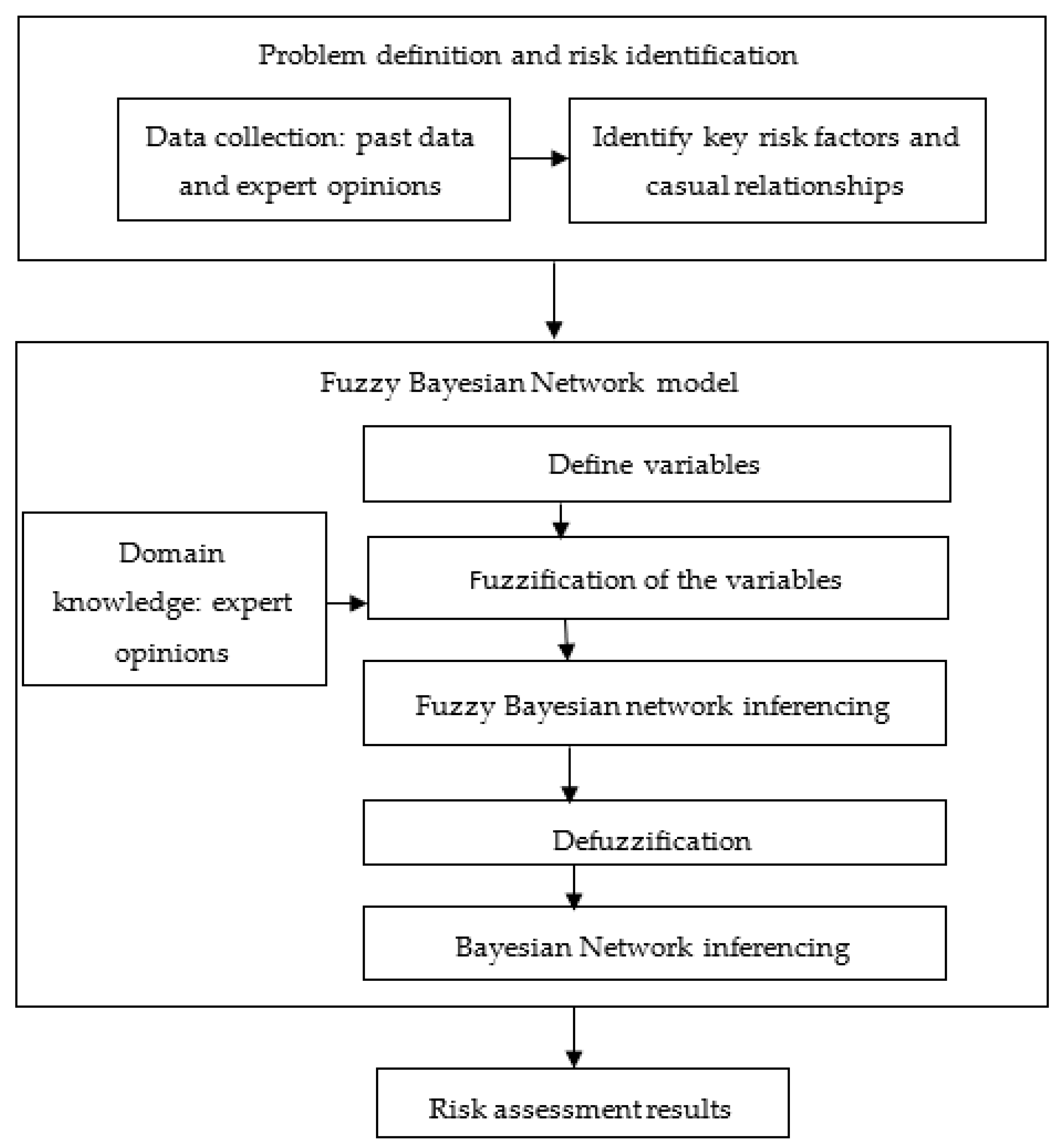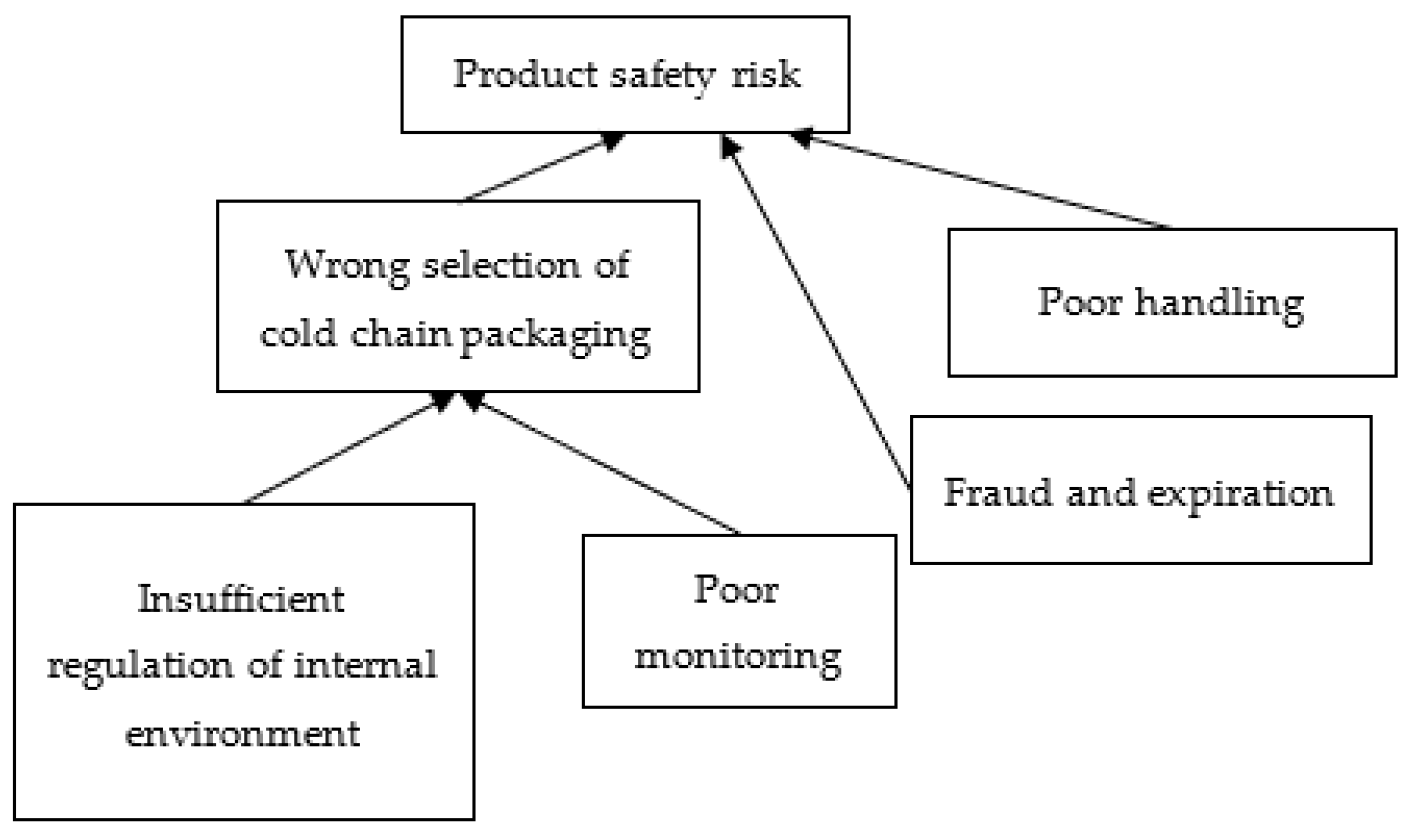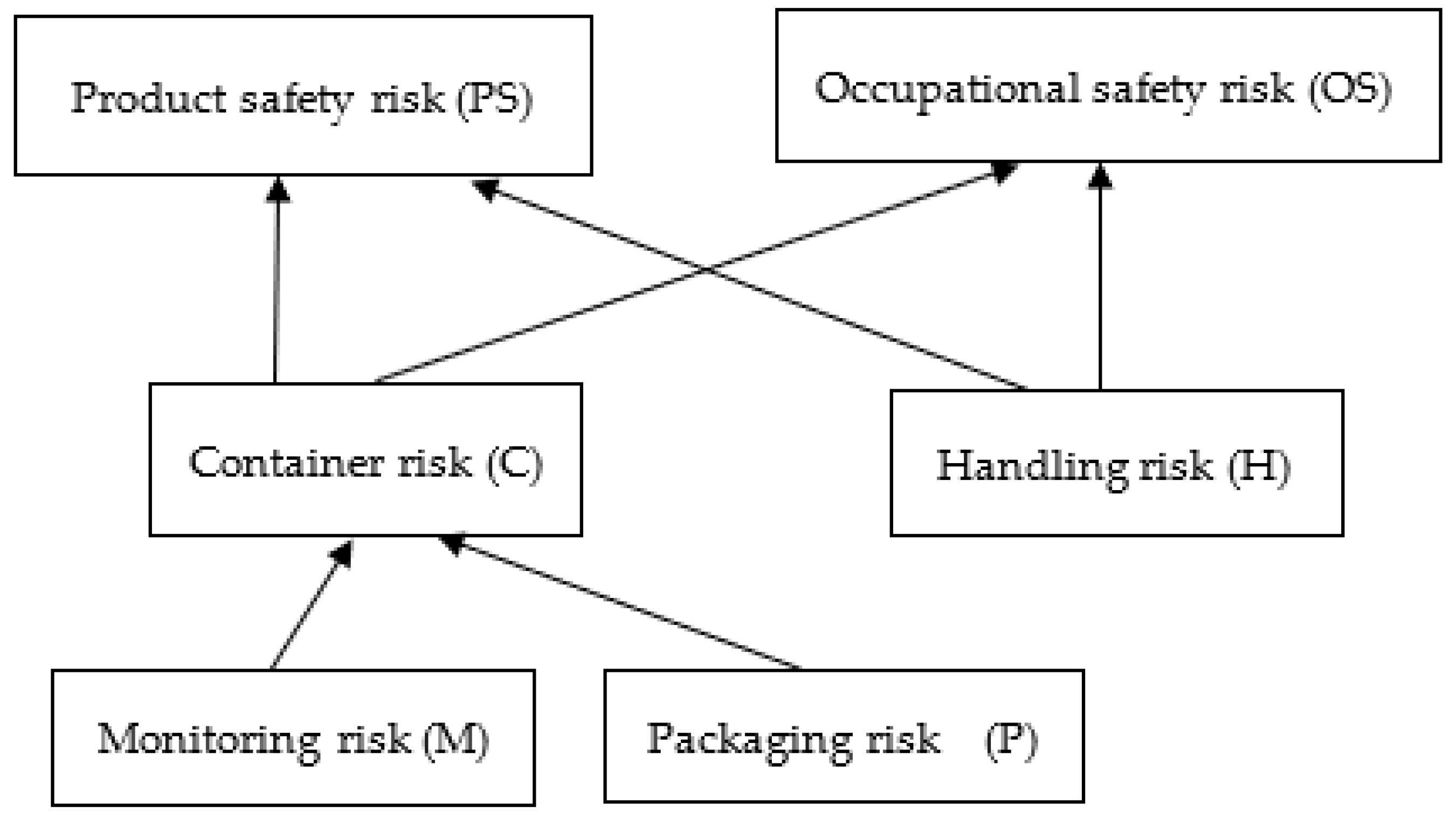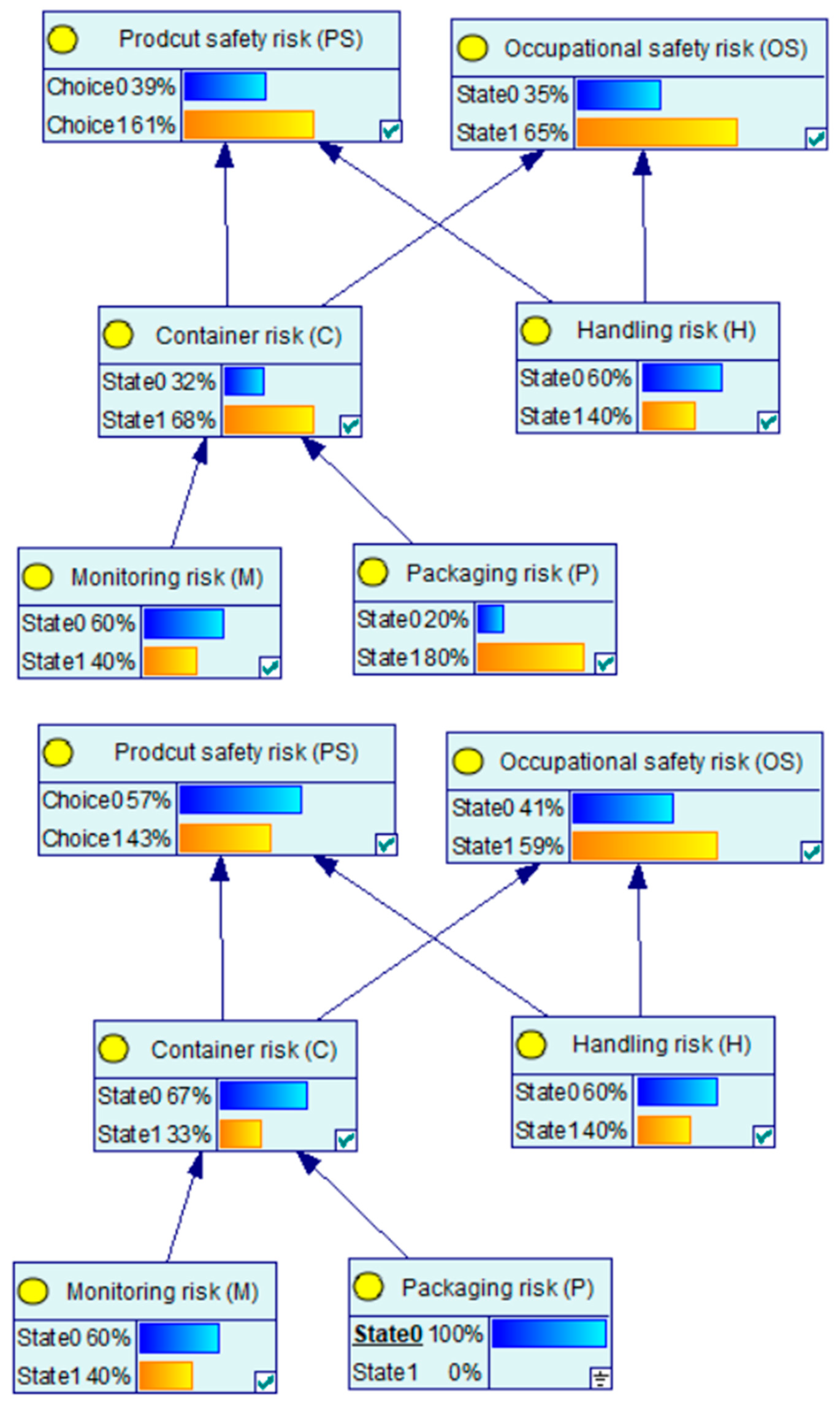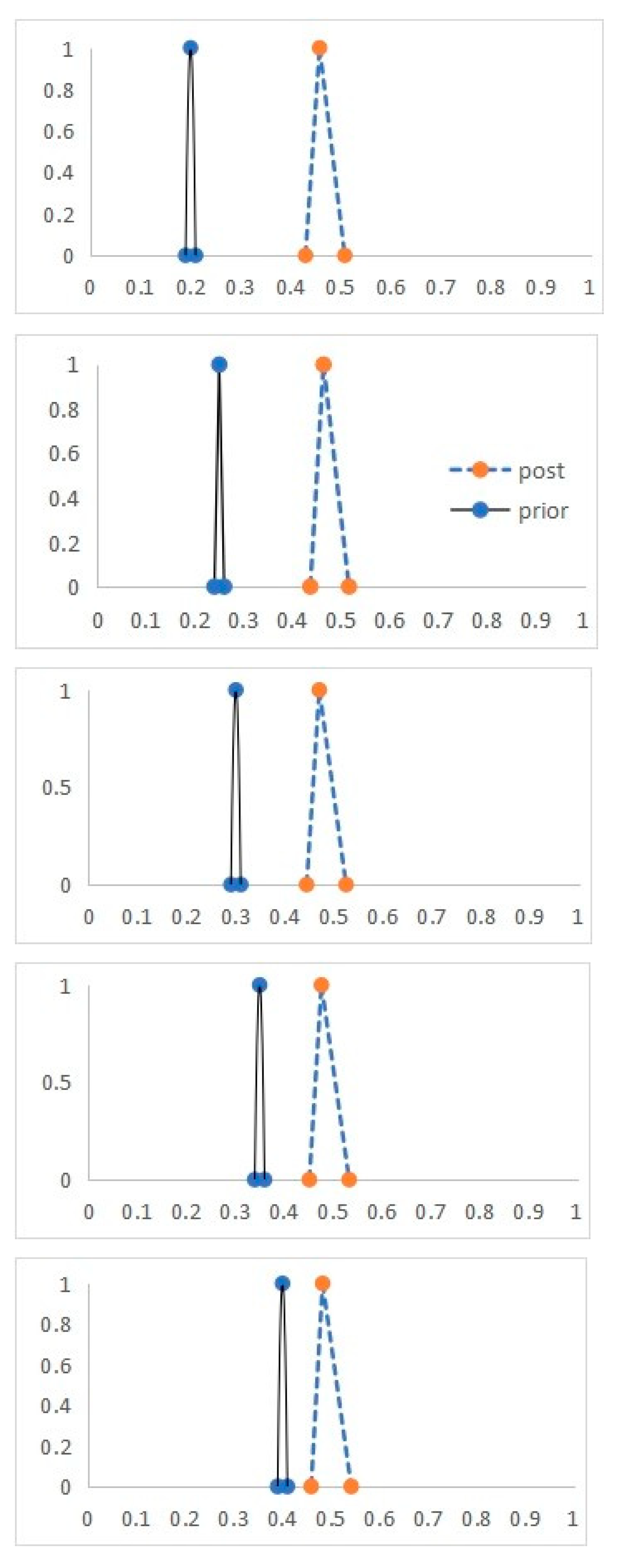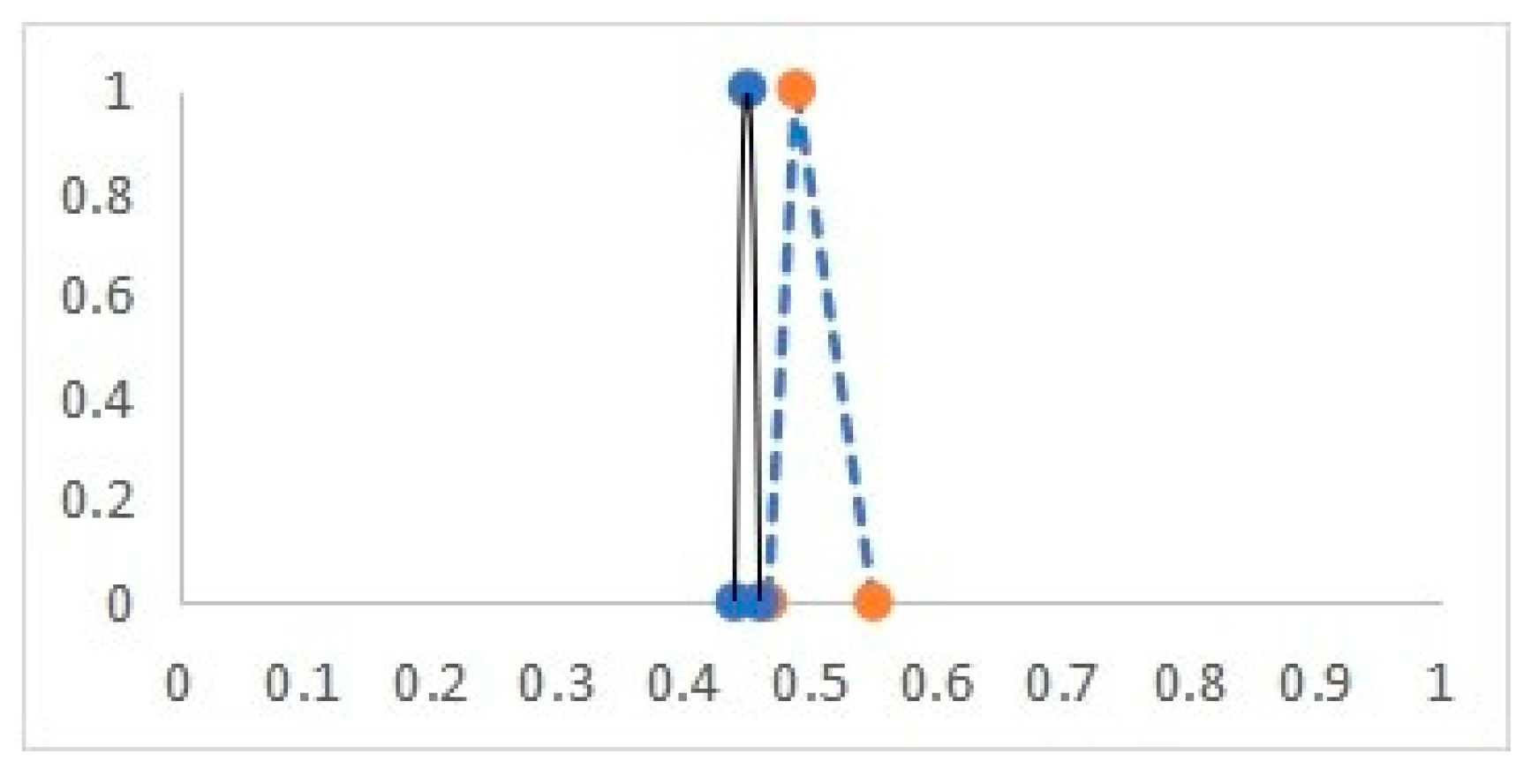1. Introduction
A cold chain is a series of activities involving the transport and storage of certain products from harvest or production to consumption or end use, and stakeholders of cold chain management include employees, suppliers, governments, financial institutions, third party logistics providers, distributors, retailers, customers, hospitals and clinics [
1]. Cold chains differ from other supply chains due to their rigid perishability characteristics, among which low temperature preservation is constantly needed. Temperature-sensitive products often need cold chains to ensure their quality and protect them from deterioration due to temperature disruptions. Failed attempts to keep them in the required temperature ranges can lead to quality deterioration, safety issues and harm to the environment. Driven by the boom in e-commerce, the advancement of people’s living standards and increasing healthcare needs, the demand for cold chain products and the number of cold chain logistic providers have increased greatly in the past few years [
2,
3]. Common temperature-sensitive products are fresh agricultural products, refrigerated and frozen food, medical and pharmaceutical products, chemicals and laboratory products, etc., of which different products have different cold chain transportation and storage requirements.
Fresh agricultural produce continuously loses its water after harvest without proper temperature control. Drying can lead to hardening, probable cell damage, gelatinization and surface hardening of agricultural produce. Therefore, maintaining the temperature and keeping the humidity at a level that is good for the preservation of crop quality is very necessary [
4]. Temperature disruptions of fridged or frozen food during storage and transportation can lead to food loss, food spoilage, bacterial growth, food-borne illness and even food poisoning, so it is important to closely maintain and monitor the temperature, therefore maintaining the quality of the cold chain food. Vaccines are also very sensitive to temperatures, as well, and insufficient temperature control can lead to the loss of vaccine efficacy and have the potential cause to health hazards. Some vaccines are very freezing-sensitive, and temperature disruptions can lead to the over-thawing of vaccines, harming their potency and effectiveness [
5]. Also, cold chain workers face potential safety hazards due to the extraordinarily cold working environment [
2]. Temperature control and safety management are critical for vaccine cold chains. Chemical and biological products such as temperature-sensitive reagents (e.g., enzymes, antibodies, growth media), DNA, RNA, proteins, etc., need to be stored in certain required temperature ranges to keep from degradation. Cold chains are very necessary to store and transport temperature-sensitive products. There are many ways to preserve the temperature during storage and transportation, e.g., fridges, freezers, cold rooms, ice, cold storage boxes, etc. Packaging is an important part of the whole cold chain design since it is involved almost along the whole cold chain. And it has also been identified as one of the main risks of cold chain disruptions [
1]. However, packaging is often overlooked in cold chain systems and safety management.
The cold chain packaging market is expected to reach USD 40 billion by 2026, with an annual growth rate of 12.92% [
6]. It is vital to study the role of packaging on cold chains and its impact on the overall safety and efficiency of cold chains. Packaging has many functionalities, consisting of containment, protection, transportation, storage, etc., and the main goals of packaging are different depending on the perspective. For example, from an economic point of view, the goal of packaging is to maximize profits while minimizing costs of delivery [
7]. From the perspectives of efficiency and personnel safety, packaging should maximize ergonomic design and ensure safety. Packaging used in cold chains plays an important role in regulating and monitoring the temperatures during transportation and storage. Comprehensive cold chain shipping solutions are often offered by cold chain providers. A cold chain shipping solution often includes the provision of suitable pallets, containers, monitoring devices and accessories, as well as training and recycling programs if needed [
8]. It is highly demand-driven, and customized shipping containers are often provided to meet specific end needs. For instance, due to the COVID-19 pandemic and the expansion of global immunization programs, the demand for vaccine cold chain shipping containers has increased dramatically in the past few years [
9,
10]. However, vaccine cold chains are not risk free. The rate of COVID-19 vaccine failure due to poor storage, scheduling and preparation is reported to be about 50% [
11]. Maintaining and monitoring the temperature along cold chains is of great importance since insufficient temperature control during can lead to serious quality and safety deteriorations. Many factors can affect the overall performance of the cold chain, e.g., product types, transport route, transportation modes, packaging used, etc. [
12].
Due to the complex and perishable nature of the cold chain, safety and risk management is needed to manage highly unpredictable and uncertain events during transportation and storage. Bayesian Network (BN) is a novel method for accessing uncertainties and representing links between variables and has been used widely in the field of risk management. BN originates from statistics and artificial intelligence and aims to study the uncertainty in knowledge-based systems. BN has gained increasing research attention in academia in recent years. Unlike other static techniques like faulty tree or bow tie, BN is proven to be more robust and flexible and thus has many applications, e.g., risk modelling, engineering safety and reliability management, medical diagnosis, etc. [
13]. The casual relationships and probability dependencies can be explained using BN. BN can take multiple forms of information, e.g., datasets and expert opinions, which makes it a good option for cold chain risk analysis because it is difficult to obtain perfect data for cold chains. BN also has the merit of being able to update the system with new information. This is particularly useful for complex systems, since interdependencies between risk factors have a significant impact on the overall performance, which can be solved by BN [
14]. Both forward and backward inference can be achieved using BN models. Despite all of BN’s advantages, it is still subject to some limitations. Only crisp numbers, or numerical probabilities, can be inputted into BN based models. Sometimes it is hard to obtain full data, and some people are not very comfortable with giving out numerical numbers for probabilities. Fuzzy logic reasoning can be used to address the high uncertainties of the system.
Fuzzy logic theories are often used to deal with issues with high level of vagueness and have been used widely in decision analysis, classification, approximation, etc. Fuzzy number sets were first thought up in the 1960s by Zadeh [
15] and aim to represent the degree of truth. Due to the high uncertainties of cold chains, researchers and practitioners sometimes struggle to provide adequate information or numerical data. To ease the process, fuzzy logic approaches are sometimes used to convert linguistic terms into numbers, since linguistic expressions are more acceptable than numerical values. In this way, uncertain information can be incorporated in the risk assessment. Fuzzy logic methods often include fuzzification, inference and defuzzification. Through fuzzification, experts can use linguistic terms like “high” and “low” to determine how likely a particular risk factor is to occur or to lead to the occurrence of other risk factors. Rather than using linear expressions, fuzzy membership functions and fuzzy-based rules are often used for the inference of models. Membership functions are often used to describe the fuzziness of the number based on degree of truth. Common forms include triangular, trapezoidal, Gaussian membership functions, etc. Fuzzy inference has pros of providing more flexibility and levels of probabilities when assessing experts’ opinions. Then, in the stage of defuzzification, fuzzy numbers are converted back to crisp values. Common defuzzification methods include bisector and centroid defuzzification [
14].
Fuzzy logic approaches are also subject to some weaknesses. Fuzzy reasoning techniques lack the ability to conduct inference inversely, and this can be alleviated by the BN technique, providing reasoning inference. The combination of fuzzy logic and Bayesian Network can compensate for each method’s limitations, and fuzzy Bayesian Network (FBN) can address the randomness and vagueness of uncertainty problems. Therefore, this paper aims to investigate and analyze risks on cold chain packaging by developing a risk management model based on FBN. The rest of the paper is structured as follows: A literature review on cold chain packaging and cold chain risk management is carried out in
Section 2. The conceptual framework of the FBN-based risk management diagram is discussed in
Section 3. In
Section 4, a case study is conducted using the proposed risk management model to demonstrate the applicability of the model.
Section 5 includes a discussion of results and implications. Finally, the conclusions, future work and limitations are stated in
Section 6.
2. Literature Review
Both academic and industrial researchers and practitioners have studied the topic of cold chain packaging. In academia, the term ‘cold chain packaging’ is commonly used, while in industry the term ‘shipping solutions’ is frequently seen. Existing research on cold chain packaging focuses on materials and technologies for improving temperature control, such as phase change materials (PCMs), sensors, Internet of Things (IoT), etc. Ren et al. (2021) summarize some innovative vaccine cold chain cooling systems, including both active and passive cooling systems [
8]. Passive cooling systems, e.g., PCM cold storage boxes, make delivery to rural areas where refrigerators are limited possible. PCMs are one important component in many passive cooling systems since they can achieve temperature regulation by changing their phases [
16,
17]. The application of PCMs in cold chain packaging can improve thermal energy storage efficiency, which is beneficial to overall sustainable development [
5]. Other popular cold chain materials and technologies include vacuum insulated panel (VIP), expanded polystyrene (EPS), polyurethane (PUR), dry ice, etc. Dry ice is sometimes used for ultra-low temperature cold chains, but its impact on the environment needs to be further explored [
4]. VIP provides advanced head damage control during transportation, and PUR and EPS can offer additional insulation protection for cold chain packaging.
In addition to the need to maintain the temperature, constant monitoring is of the same significance since no perfect cold chains exist. Many studies have proposed new cold chain detection and monitoring techniques [
18,
19,
20,
21]. The application of monitoring devices in food cold chain packaging is summarized by Singh et al. (2018) [
1]. Temperature data loggers, sensors or indicators are often needed for cold chain monitoring. Temperature indicators utilize the inversible color change of physicochemical responses through microbial growth, solid state reactions, polymerizations, diffusion, etc. [
22]. Gao et al. (2020) developed a new temperature excursion indicating material based on the mixture of a phase-change material with photochromic spirogyra compounds that can change color once the temperature reaches 8 °C [
21]. Sustainable materials have been used in some applications, and wide ranges of temperatures can be achieved. Cui (2023) developed a nano-temperature sensor based on paper for cold chain storage with multiple temperature thresholds from −68 °C to 4 °C [
23]. Apart from temperature indicators, data loggers are often used to keep track of the temperature and humidity data. The data can be stored in the memories of data loggers and can be transmitted to a central management system. There are single-use and multi-use data loggers, and to select suitable data loggers, factors like temperature range, capacity and accuracy need to be considered. Sensors and data loggers are usually placed in freezers, refrigerators, vehicles or cold rooms or integrated with the packages and containers. Other inspection tests are sometimes carried out for specific cold chain products. For instance, shake tests are often performed to freeze sensitive vaccines to detect any physical damage in vaccines, and Briggs et al. (2020) have developed a wNMR method to test if the vaccines have experienced freezes/thaws [
20].
Studying cold chain packaging on its own is sometimes not enough, since many other factors have an impact on its performance and efficiency. During the design of cold chain packages, it is important to consider and evaluate the supply chain, stakeholders, temperature control and monitor requirements, transportation mode and regulations, product protection feature, ergonomic design and overall sustainability, and to select the right materials and size. Some previous studies have considered the supply chain management aspect during the packaging design phase [
24,
25,
26]. Different supply chains have a significant impact on the packaging. Considering that the supply chain during packaging designs can increase overall efficiency, minimize waste, and maintain product quality and safety to the greatest extent. Due to the complex nature of cold chain packaging, it is subject to many risks during transportation and storage. Therefore, safety and risk management are important for cold chains.
Supply chain risk management includes risk identification, assessment, mitigation and monitoring [
27]. The identification of the risk factors and risk mitigation strategies of cold chains is often carried out through a literature review, field observations and expert opinions, and the assessment of the risk factors is undertaken using a varied range of methods such as constructing a hierarchical structure, addressing causal relationships and classifications, etc. Food or agricultural cold chains have received most of the research attention [
17,
28,
29,
30,
31,
32,
33,
34,
35,
36,
37,
38,
39,
40,
41]. Most of the studies regarding cold chain risk management focus on theoretical aspects in which risk factors are derived from the literature and data, while some concentrate on empirical studies, in which risk factors are identified from expert opinions and field observations. Different cold chain risk management studies have different focuses, e.g., concentrating on technologies used in cold chains, different links of cold chains, the supply chain management of cold chains, the information or financial flow of cold chains, etc. Cold chain performance metrics include occupational safety, customer satisfaction, cost, the efficiency of cold chains, company development and reputation, shelf life of the products, temperature disruptions, etc. Cold chains have many links, which include transportation and distribution, processing and packaging, information processing and warehousing, and Zheng et al. (2021) identified transportation and distribution as the most influential links leading to cold chain failures [
40].
Different cold chain risk management studies have covered different types and ranges of risks, e.g., operational risks [
13,
40,
42,
43], packaging risks [
29,
37,
40,
41,
44,
45], supply chain risks, fraud risks [
33,
44], temperature disruption risks, etc., and have categorized risks in different ways. Dagsuyu et al. (2020) added budget and time constraints to the proposed risk mitigation actions to investigate the impact of the actions on risk factors considering cost and duration [
37]. Common risk factors that can lead to disruptions of cold chains include natural risk, supply chain risk, logistic risk, quality risk and packaging risk. Natural disasters and emergency events like political instability, power outage, strikes, extreme weather, traffic instability, etc., make it difficult for cold chains to function properly [
1,
17,
28,
29,
30,
34,
35,
36,
41,
43,
46,
47,
48,
49]. Integration and information sharing are important to the efficiency of cold chains, and a lack of integration can lead to supply chain and logistic disruptions. Supply chain and logistic-related risks include supply delays, market instability, forecasting errors, poor infrastructures and devices, lack of information sharing, human errors, economic instability, etc. Good infrastructure can not only maintain the product quality and safety but also reduce time, cost and waste. However, cold chain facilities and equipment are sometimes still not sufficient as related risks still exist, which, for example, include poorly refrigerated equipment or vehicles, pre-cooling not being up to standard, machines being too old, etc. Not only does the ‘hardware’ of cold chains sometimes not meet the standards, the ‘software’, e.g., monitoring, data and information management, may be lacking as well. Information sharing is still lacking sometimes, and the improvement of information sharing can enhance the responsiveness of inquiries along the cold chain [
1,
2,
17,
28,
29,
30,
32,
34,
35,
36,
38,
39,
41,
42,
46,
47,
48,
49,
50].
The ultimate goal of cold chains is to transport and store certain products while maintaining the product quality and safety. The quality and safety of the cold chain products are therefore of significant importance, and many risks can lead to quality and safety deteriorations, e.g., contamination with other substances, the presence of bacteria, mechanical damage, etc. This can lead to adverse health hazard events if quality and safety are not ensured [
29,
32,
33,
34,
43,
44,
47,
49,
50,
51,
52,
53]. Zhang et al. (2020) conducted a risk assessment for a medical provider and emphasized the importance of quality assurance and information on cold chains [
35]. Another factor that may cause adverse effects on cold chains is the packaging- and processing-related risk. Packaging plays an important role along the whole cold chain, and temperature control and monitoring may be disrupted because of unsuitable packaging materials, incorrect processing and packing and damaged packaging. Also, sometimes the packaging design may lack sustainability considerations along the cold chain, leading to waste and contamination. Packaging is especially essential during loading and unloading since the products are not protected by refrigerators. Proper packages can keep the product temperature within desired ranges during between-links. In addition to selecting suitable packages, the handling of the packages also affects the cold chain performance. Insufficient training and instructions can lead to the incorrect handling of the packages, causing temperature disruptions. Unsafe packaging materials or a lack of sanitation may cause harm to personnel safety [
1,
29,
32,
35,
37,
40,
41,
46,
48,
49]. To increase the sustainability of the cold chain, the application of new technologies and the use of energy-efficient refrigeration systems have become the new trend [
1].
Many decision-making techniques have been selected for risk assessment in cold chain risk management studies, such as Bayesian Network, analytical hierarchical process (AHP), fuzzy inference system (FIS), etc. For studies concentrating on supply chain risks, the method of supply chain operation system (SCOR) is sometimes used so that the activities of the supply chain can be mapped before risk assessment, and house of risk (HOR) and pareto diagrams are often used to prioritize the risk factors. Bayesian Network is used in some fraud risk management studies on food cold chains [
33,
44]. Some studies analyze the casual relationships and probabilities of the cold chain risk factors using the Bayesian Network method [
36,
40,
46]. Other popular methods include AHP, ISM, TOPSIS, FIS, machine learning algorithms, etc. AHP is good for prioritizing risk factors or mitigation strategies, as well, and has pros of high flexibility and simplicity. Singh et al. (2017), Joshi et al. (2021), Khan et al. (2022) and Dagsuyu et al. (2021) used AHP for their cold chain risk management models [
2,
37,
41,
51]. Zhang and Han (2020) used interpretative structure modeling (ISM) for their risk control model, in which a hierarchical structure is built through adjacency and reachability matrixes [
35].
Most methods require the ranking or defining of probabilities based on human judgement and historical data; however, sometimes people may not be very comfortable assigning numbers to probabilities of occurrence for events, and nor it is easy to obtain perfect data. Therefore, fuzzy logic reasoning is sometimes used in risk assessment to deal with system uncertainties. Many cold chain risk management studies have incorporated fuzzy logic into their risk assessment systems [
17,
28,
31,
36,
37,
38,
40,
43,
47]. Experts’ judgements are needed to decide which fuzzy membership shapes and rules are used. Trapezoidal and triangular membership functions are the most frequently used methods due to their simplicity. Rule-based fuzzy inference is often used to determine the correlation probabilities between parameters. Tsang et al. (2018) proposed a dynamic fuzzy occupational safety risk assessment model including input parameters like body mass index, age, average heart rate, average calories burnt and work experience. Different fuzzy classes are used for different parameters [
52]. The ‘average heart rate’ parameter is defined as {slow, average, relatively fast, fast}, and the ‘work experience’ parameter is defined as {low, average, high}. Trapezoidal and triangular membership functions are used for different fuzzy classes based on experts’ opinions.
4. Case Study
The global expansion of immunization programs, humanitarian supply chains and the pandemic disruptions of COVID-19 have increased the demand for vaccines in the past few years. A vaccine cold chain starts from when the research and development of the vaccines begin and then goes through manufacturing, transportation to national and regional storage facilities, and next moves to health centers or to outreach, all in refrigerated environments during transportation and storage. The WHO (2024) now has humanitarian vaccines for more than 20 life-threating diseases, including diphtheria, tetanus, pertussis, influenza, measles, etc., which can prevent about 3.5 to 5 million deaths every year [
54]. Therefore, this case study aims to develop a risk management model for vaccine cold chain packaging.
Risk factors leading to product safety risk and occupation safety risk are illustrated in
Figure 2 and
Figure 3. To ease the calculation process, the risk assessment focuses on vaccine shipping container risk and handling risks, illustrated in
Figure 4. Shipping containers contain monitoring devices and materials and devices for regulating the internal environment in the container. The risk factors for vaccine cold chain shipping solutions are listed in
Table 1, and include product safety risk, occupational safety risk, container risk, handling risk, monitoring and packaging risk. Possible causes of these risks are included as well as the possible consequences.
The product safety risks are risks that can cause potential health and safety hazards due to vaccine quality deterioration. Contaminations, a loss of vaccine potency, over-thawing and mechanical damage can lead to product safety issues. This can lead to hazards, like vaccines not being effective, or can even cause harm to health. Occupational safety risks are risks that can cause harm to cold chain workers’ health and safety due to the extraordinarily cold working environment or improper training, and this can lead to injuries or cold-related diseases, or to slipping on cold surfaces. Container risks are risks that can damage the shipping containers, and this can lead to temperature disruptions, quality decay and safety hazards. Potential causes of container risk include poor packaging or monitoring of the cold chain. Handling risks are risks that can lead to product or occupational safety issues due to incorrect handling, which can lead to safety hazards, damage to products, injuries and waste. Factors that can lead to handling risk include insufficient personnel training, vague instructions, lack of sanitation, etc. The monitoring risk refers to risks that cause monitoring disruptions and have the potential to cause over-thawing, lack of traceability, temperature disruptions, etc. Insufficient or poor monitoring devices and poor traceability can cause monitoring-related risks. The packaging risk refers to risks that can cause damage to the packages, resulting in packaging not being able to provide sufficient temperature control or harming the environment. Potential causes of packaging-related risk consist of the use of improper materials, improper capacity, unsafe packages and packaging having a lack of sustainability.
Domain experts have been asked to describe the prior and conditional probabilities of the nodes. In this case study, a seven-point Likert point scale was used, as recommended by the International Maritime Organization (IMO), as shown in
Table 2. Triangular fuzzy membership sets are used for the fuzzification step. All membership functions in this case study use narrow ranges of intervals for calculation so the spread of the posterior probabilities is not too wide.
Table 3,
Table 4 and
Table 5 demonstrate the fuzzy prior probabilities of nodes M, P and H. For node M, there are two possible values, M1 and M2. The occurrence possibility is described with the linguistic term ‘Possible’. Then, the linguistic term is further described as a fuzzy triangular set (0.49, 0.5, 0.51) based on the value range in
Table 2. The most likely value of M1 is 0.5. The lower and upper likely values of M1 are 0.49 and 0.51. Similarly, node P and H have fuzzy number sets of P1 (0.19, 0.1, 0.21) and H1 (0.59. 0.6, 0.61).
Table 6,
Table 7 and
Table 8 demonstrate the fuzzy conditional probabilities of nodes C, PS and OS. The conditional probabilities of ‘container risk’ concerning ‘monitoring risk’ and ‘packaging risk’ are listed in
Table 6. The fuzzy probabilities of all combinations of the causes are listed. ‘Container risk’ is extremely unlikely to happen if ‘monitoring’ and ‘packaging risk’ are not present, with a fuzzy possibility of (0.04, 0.05, 0.06). If both monitoring and packaging risks are present, then ‘container risk’ is likely to happen frequently, with a fuzzy possibility of (0.74, 0.75, 0.76). When there is only ‘monitoring risk’ and no ‘packaging risk’ present, then ‘container risk’ is unlikely to happen, with a fuzzy possibility of (0.34, 0.35, 0.36). When there is only ‘packaging risk’ and no ‘monitoring risk’ present, then the ‘container risk’ is possible, with a fuzzy possibility of (0.54, 0.55, 0.56). Similarly, the conditional probabilities of ‘product safety risk’ and ‘occupational safety risk’ are listed in
Table 7 and
Table 8.
Figure 5 details the BN-based risk management model for vaccine cold chain shipping containers, and a sensitivity analysis was carried out. The purpose of a sensitivity analysis is to analyze the impact of changing an independent variable on a particular dependent variable, therefore showing how uncertainties in different inputs can affect the overall uncertainty of the model [
13]. To conduct sensitivity analysis, changes to the prior probabilities of one variable are needed, and the changes to the posterior probabilities are logged to assess the impact. For this case study, the variable ‘packaging risk’ is selected for sensitivity analysis, and seven different values are inputted, which include (0.19, 0.2, 0.21), (0.24, 0.25, 0.26), (0.29, 0.3, 0.31), (0.34, 0.35, 0.36), (0.39, 0.4, 0.41), (0.44, 0.45, 0.46) and (0.49, 0.5, 0.51). The corresponding posterior probabilities are calculated and shown in
Table 9, and as P(P = P1) gradually increases, P(PS = PS1|P = P1) steadily increases, which is also shown in
Figure 6, validating the reliability of the results.
5. Discussion
Many factors can lead to product-safety-related risks for vaccines, including temperature disruptions, insufficient monitoring, fraud, poor handling, supply chain and environmental risks. For vaccines, exposure to temperatures outside the recommended temperature range can cause great damage to the vaccines. Temperature disruptions above or below the recommended range can lead to negative impacts on the safety of the vaccines. The quality of the vaccines will be harmed, which can cause adverse impacts on people’s health. Also, fraud can be an issue for the safety of vaccines since fraudulent vaccines do not follow the strict guidelines during manufacturing, and insufficient refrigeration and monitoring is used in the shipping solutions. And poor handling of the shipping containers can cause damage to the vaccines as well.
Exposure to heating can damage vaccines by changing the tertiary protein structure, dissociating polysaccharides from protein carriers in polysaccharide conjugate vaccines and reducing live-attenuated vaccines’ infectiveness. Usually, the impact of heat damage is cumulative, and one solution is the use of Vaccine Vial Monitoring (VVM), in which a sticker or label is affixed to a vaccine vial and aims to estimate the remaining shelf life of vaccines when exposed to continuous heat [
55]. The mechanism of VVM is the color change based on the Mean Kinetic Temperature (MKT), which indicates the total thermal stress a vaccine experiences in a period [
56]. In addition to vial monitoring, other monitoring methods are needed in the vaccine cold chain shipping container, e.g., the use of data loggers and sensors, etc. In addition to the potential harm from heat damage, vaccines shipping containers can be subject to freezing as well.
The freezing of vaccines can also affect the vaccines adversely, e.g., by causing clustering of the adjuvanted particles, antigen degradation and molecular changes of vaccines, posing additional stress to the cold chain [
57]. The WHO Shake Test is designed to detect whether freezing happens in a vaccine vial. During a Shake Test, first, one vial from a batch is selected as the control vial. Then, it is frozen overnight and thawed afterwards. Second, another vial is selected for testing, and then a visual comparison of the sedimentation rates of the two vials (control and testing vials) is made. When the sedimentation rate of the test vial is the same or greater than the controlled one, it is an indication that freeze/thaw occurs in this test vaccine vial. In this case, the whole batch of vaccines should be abandoned [
58]. However, a shake test is usually carried out on one vial of a pack.
Poor handling of the vaccine cold chain packaging can lead to product safety issues. Improper handling can lead to damage to the passive cooling systems, e.g., the leakage of PCM packs or bottles, sensors being broken, vial leakage, etc., and this can lead to hazardous consequences to vaccines and cold chain personnels. And for vaccines which require ultra-low cold chain storage and transportation, liquid nitrogen and dry ice is used sometimes, and improper handling of these substances can cause safety hazards. Also, improper handling of the vaccine packaging can harm the air circulation and compression forces, which can lead to physical damage to the packages and temperature disruption.
Fraud and the expiration of the vaccines are other issues that can lead to vaccine safety risks. Expired vaccines have decreased potency and are more likely to cause safety issues to human bodies. Vaccines are usually monitored by government supervision departments, and random sampling tests are required to ensure vaccine safety. A lot of data will be generated along with the vaccine shipping solutions, such as batch packing records, batch production records, inspection records, inoculation records, etc. But it is still possible to tamper with the records. Information technology management systems like IoT and blockchain can be used to manage the data. But they may be subject to cybersecurity-related problems.
Occupational-safety-related risks are important as well. Working in a low temperature environment is certainly not risk-free, and rigid monitoring is needed most of time. A lack of personal protective equipment (PPE) and poor training and handling of the packages can all lead to occupational-related risks. Vaccine cold chain packaging workers sometimes need to work under cold chain or ultra-low temperature environments. Repetitive exposure to cold environments can cause some health hazards. Exposure to cold environments can cause injuries and cognitive and motor impairments such as impaired tactile sensitivity, muscle function, proprioception, finger mobility and grip strength, as well as increasing arousal levels and distracting attention [
59]. Lack of personal protective equipment (PPE) and a lack of training and monitoring can lead to unprotected exposure to cold environments. Poor handling of the packages can lead to physical harm to workers, and broken packages can cause a leakage of phase change materials, refrigerants, which are hazardous and can harm human health.
Real-time monitoring and efficient training should be given to relevant personnel working with cold chain packaging. Monitoring systems should be able to handle vague information and aid in decision-making, and personalized training should be given to relevant personnel. With the emergence of information management and AI technologies, many applications have incorporated these techniques. Zhan et al. (2022) proposed a real-time occupational safety monitoring system based on IoT and digital twin technologies [
60]. Thielmann et al. (2020) proposed an online learning program called Keep Cool to ensure optimal vaccine storage conditions with the aid of tailored training for individuals [
61]. Individuals may have different tolerances to the cold environment, and factors like body fat, level of physical fitness, diet, blood pressure, heart rate, skin temperature, mean body temperature, core temperature, etc., impact the cold adaption of individuals. Tsang et al. (2018) proposed an IoT-based risk monitoring model to manage personal health data in cold chains [
52].
Specially designed cold chain shipping containers are often used for vaccines. These shipping containers normally contain packaging systems to maintain temperatures at specific ranges and monitoring systems to keep track of the temperature fluctuations. However, poor shipping container designs can cause temperature disruptions, leading to vaccine quality and safety decay, and human errors can also lead to safety issues or even cause injuries. Poor handling of these containers can lead to product- and occupational-safety-related risks. Thus, it is crucial to conduct safety and risk management for vaccine cold chain shipping containers.
Cold chain shipping containers can provide regulation on the internal environment as well as monitoring throughout the cold chain. Also, many companies have launched training, recycling and reusing programs along with the cold chain shipping solutions. Personalized solutions are usually provided, meeting the specific requirements of the cold chain. Therefore, the risk management of product and occupational safety risks for vaccines from the perspective of comprehensive shipping solutions needs to be analyzed. Therefore, logistic providers can locate their weak chains and continuously improve their operation process.
